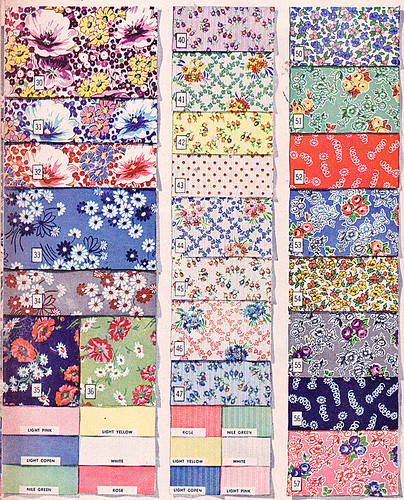diy: sdsa fabric

I've decided to consolidate the fabric and stabilizers post into one, as well as move the start date for the muslin up a bit to allow for those that have ordered their paper patterns to get them. If you'd like to take a look at the new schedule, I've edited the original post here.
One of the biggest features of any garment you sew is fabric selection. This can be especially tricky with vintage patterns (most up until the 50s don't include any suggestions!), but happily Jennie has included several suggestions that can serve both as literal and "clues" to the type of fabric this dress is most suited for! Even if we can't choose from the array of (drool-worthy!) rayon fabrics that designs like these were whipped up in back in the day, there are still plenty of options for the modern seamstress. The pattern recommends:
Crepe, heavy rayon, rayon/poly blends, silk charmuese, lightweight wool.
Cotton voile or lawn, georgette in silk or blends, a very lightweight and soft linen, sueded rayon or silk, soft eyelet.

Notice all these fabrics are soft or the sort that have good drape, and are lightweight. If you're unfamiliar with any of these fabrics, I highly recommend Claire Schaeffer's Fabric Guide or this online textile dictionary for a description of the fabric you're considering. Let me also say here that I strongly do not recommend quilt-weight cottons. Generally these fabrics are stiffer than what is suited for most (not all) garment designs, including this one. Stick with a fabric that is a garment weight, and you should be good. I know it can be hard with all the adorable reproduction prints available in the quilting department, but trust me: I've made that mistake in the past and it can make or break how the finished garment looks.
As I mentioned in the supplies post, you certainly don't have to stick with a fabric that reads as "1940s". This dress looks equally stunning in a classic solid or modern print. You could even go with a 70s print for a different look! Your imagination and aesthetic preferences should lead the way on picking color or pattern--have fun! I do want to mention that because of the pattern pieces in the skirt, lining up plaids, stripes or other directional prints that need to be matched may be tricky. I won't be able to cover that from start to finish in this particular sew-along, but if you choose to go with one of those I'm sure I can dig up some references for you!

Now let's talk a bit about stabilizer--also known as interfacing. Firstly, I do not claim to be an expert on this subject and am only offering my personal opinions/preferences and what I've discovered. Though the pattern does not call for it (as it is with most 40s-era patterns), I have found that adding interfacing to the midriff really helps how the dress lays over the stomach and adds some stability to a curved join that otherwise has a tendency to stretch or pull around. If you're opting for an lightweight fabric (such as a rayon challis, for instance), I usually go with a very lightweight interfacing--one of my favorites is a fusible knit interfacing. I know it seems counter-intuitive to use a knit interfacing, but it does give a little bit of stability to the area but usually does not affect the weight of the garment fabric. For slightly heavier fabrics I got with a light-medium weight interfacing. If you're using a semi-sheer or sheer material, you will have to experiment a bit to determine what would be the best option for stabilizing. I do not recommend using a fusible in this instance--sew-in is the way to go. Some options could be: self fabric, silk organza or cotton voile in a similar hue. Further reading: Thread's interfacing brands chart and SewBox guide to interfacing.
You will need to experiment a bit with picking out an interfacing to suit your fabric if you're unfamiliar with them. If I'm not sure how an interfacing--especially a fusible one--will affect the drape and weight of a garment fabric, I always do a test swatch first (usually an 8"-10" square suffices so I can see how the drape looks). Sometimes the adhesive makes the fabric too stiff and I have to try something lighter or switch to a sew-in. Generally, the rule of thumb for this particular project will be: when selecting and apply a stabilizer, you do not want to dramatically affect the "hand" or drape of the material. Meaning you don't want to make it as stiff as a board or dramatically heavier or bulkier than it is without the stabilizer. Not only does this make the interfaced area drape differently than the rest of the garment, but can make for bulky seams!

Oh, and this is totally off-topic, but this post marks the 900th post on Elegant Musings! Hooray!

Comments
Post a Comment
Thank you so much for taking time to comment! I LOVE hearing feedback from readers. I welcome truly constructive and thoughtful critique and suggestions, but will not hesitate to delete spam or downright rude comments.